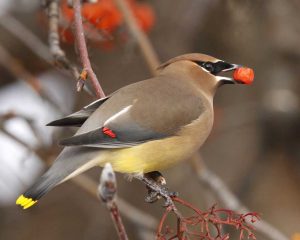One Billion Pounds of Seeds
Each year the people of the United States and Canada feed birds over one billion pounds of seed. People supply the birds with food to just watch them, enjoying their antics and their habits. But there is more to it than just pounds of seed. Birds, under the right circumstances, can pay us back twofold for all that seed. Our fine feathered friends are the wingmen in the war on bugs. Seed is not the birds’ main source of food.
Bugs munch on plants, fruit, trees, wood, and us. Some bugs are so bothersome they kill their hosts like bark beetles and Asian citrus psyllids. Ready, willing, and able to assist in the bug wars are your neighborhood birds. Open your yard to these hungry platoons and watch the bug population slow to a trickle.
In helping the farmers, the University of California Agriculture and Natural Resources did research on the actual benefit of birds in fields. There are target bird populations that go after pests, not crops. Supporting bug-eating birds was the premise, and tracking the bug population provided the bottom line. To substantiate their findings, the researchers glued codling moth cocoons to walnut tree trunks, some cocoons were covered and inaccessible to the birds. If moths emerged, they would produce a larva that would, during the following spring, damage the nuts.
By attracting the birds with desirable living requirements, the birds went to work on the codling moth cocoons. The end result was that the birds increased control of the pests from 11% to 46%. The increase of habitat also increased the demise of the pests up to 1/3 of a mile away as birds moved into the area and made it home. The habitat that was used was hedgerows bordering the farmland.
Hedgerows are the opposite of acres of lawn. The habitat that is in high demand by the best bug eaters has an assortment of trees, shrubs, perennials, and even annuals. Conifers are high-demand real estate for birds by supplying winter shelter, cover, and summer nesting spots. Grasses provide seeds and cover for birds that prefer to be on the ground. The summer fruiting plants provide food, bugs, and shelter to many, including robins, towhees, and chickadees. Plants that produce fruit in the fall help the migratory birds, and those that stay put. Dogwoods, winterberries, and cotoneasters all provide food. By gearing the habitat to particular types of birds you want, those birds then move in and continue to attract similar birds, increasing populations of bug eaters.
Only a quarter of their food comes from a feeder. Naturally, different birds have different favorite bugs. Chickadees focus on aphids, whitefly, scale, caterpillars, ants, and earwigs. Sparrows like beetles, caterpillars, and cutworms. Titmice happily devour aphids, leafhoppers, caterpillars, and beetles. Grosbeaks like larvae, caterpillars, and beetles. Nuthatches look for tree and shrub insects like borers, caterpillars, ants, and earwigs. Larger birds, like scrub jays, juncos, blackbirds, and robins, will enjoy crickets, moths, beetles, and grasshoppers. The list of birds in the Sonora area is much larger than those listed here. They are all hungry and ready to participate in the war on bugs.
Bird areas need a few more attributes to become five-star habitats. There also needs to be water for drinking and bathing. Bird feeders need to be in the right spot – not too exposed for some, for others, in an area where they can swoop in. If you have several feeders, keep them 3-4 feet apart. There are some birds that decide they own that feeder and will not share. Vary the food to vary the types of birds that come to stay.
Birds are our allies in reducing the bug population. By working with Mother Nature as our partner, we reduce pesticides and bugs, all for a better world.
Julie Silva is a University of California Cooperative Extension Master Gardener of Tuolumne County.
UCCE Master Gardeners of Tuolumne and Calaveras Counties can answer home gardening questions, call 209-533-5912 Fill out our easy-to-use problem questionnaire here. Check out our website here, You can also find us on Facebook.

